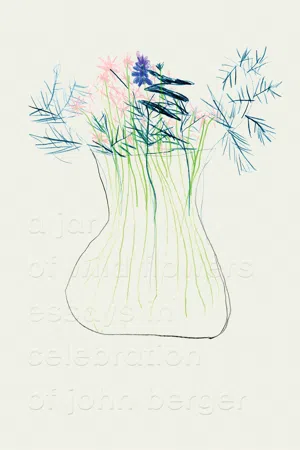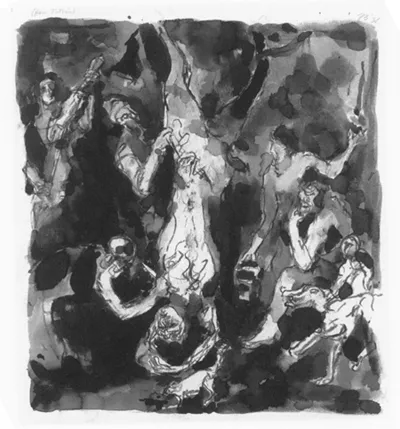![]()
THE COLOUR OF THE COSMOS
![]()
GRAPHITE
FOUR POSTCARDS
HANS JÜRGEN BALMES
1 IN THE MOUNTAINS
We are sitting in the kitchen in Quincy. Suddenly the room gets dark. High in the mountains, electricity is not a given thing. Blackouts are frequent, can last hours. John Berger rises, walks over to a cupboard, comes back, and lights a candle.
We are squinting into the flickering light.
John Berger moves his lips silently as if he wants to lure some words from the dark. He twitches his eyes, waits as though he has been inventing an ambush for words. Finally: ‘Now our faces are paintings, in electric light we are photographs.’
Candlelight makes the shadows hospitable. With some hesitation, John Berger clears his dish, takes out a manuscript, puts it on the table, shuffles, and finally irons the pages with his elbow. He reads, slowly but with confidence. Again we have the impression that he has to cross some distance before he begins – a line of graphite to remember a gap, a silence before gaining a foothold, but into where? We are not sure, but we feel, as though we are there.
Maybe it is exactly these interstices that John Berger addresses in one of his last essays discussing translation: ‘Because true translation is not a binary affair between two languages but a triangular affair. The third point of the triangle being what lay behind the words of the original text before it was written. True translation demands a return to the pre-verbal.’1
Experience demands a return to the pre-verbal, to where thinking starts and words attach themselves to the stirring tongue of the mind.
The pauses are proof of the distance that has to be covered. And making the distance visible is a form of offering hospitality to images and words, to listeners and readers. Stepping towards that point and stepping back.
2 ROAD DIRECTIONS
Sometimes the Inuit – people who have great shamans – carry a black stone inside their parkas: graphite that they have found in dry brooks during the summer while travelling inland. They put it into their amulets. Before going on a whalehunt. They use it to draw black lines on their bleached paddles: Alinnaq, the moon spirit with his face black with soot, will help them on their dangerous journey. White symbolises life, which now hunts in companionship with death – black and white have become partners.
3
From Titian, John Berger, 1996
If you look at the John Berger drawings From Titian,3 and if you compare these to the paintings of the Venetian master, soot and graphite cross your mind. On Titian’s paintings black soot surrounds the figures like velvet. Its black has nothing in common with the cold black wall that blocks the backdrop of a memento mori. Titian’s black is warm. It is a soft tissue surrounding the flesh. It is the grounding from which the honey-coloured light of his paintings takes their energy.
It seems that for Titian there was no difference in whether this light was shed on the Crucifixion, on the image of a nymph, or on the representation of the Flaying of Marsyas. The latter shows how the satyr Marsyas – the loser in a contest to decide who is the best reed-player – is being flayed by the victorious Apollo. It is one of the cruellest representations from a city whose inhabitants had been aware of manifold levels of cruelty. In Venice it was a common punishment for a capital crime to be sentenced to the galleys. This was called the ‘thousand-fold death’. Of course members of the gentry (members of the same tribe) were excluded from such toil. The judges of those courts were Titian’s clients. The soft warm light that falls onto the mythological scene of torture lends a feeling of unease and brands the painting as one of the most enigmatic in the long history of art. What did Titian think about it? His pity seems to be impartial. His attention seems to be the same towards the victim as towards the torturer. The light shed on this scene seems to be the same as in a picture of a naked woman under a tree, which he painted nearly simultaneously.
An element of unease in Titan’s composition is the starting point of John Berger’s drawing. His drawing concentrates on telling aspects of the painting: the satyr that hangs head over heels from a tree, the white right arm wielding a knife, the king – a figure of melancholy –who contemplates the scene, the second satyr who carries a bucket, which perhaps contains blood that the small dog in the foreground has already begun to lick. A big dog stands next to the brooding figure with downcast eyes, and scans the scene. Its jaws are open. Its tongue seems to taste, its nose to smell. The animal is aware of the distance from where the brooding figure contemplates the scene and of the indifference of the small dog to the cruel origin of the blood it laps. In the image, the large dog appears to move. Its contours have been drawn two, three times, as if Berger did not have a patient piece of paper before him on which to copy but observed a procedure that he wanted to capture in all its density. Or perhaps he wanted to underline that being immobile like a statue renders it impossible to cope with the complexity of the scene – because if the ‘wait between decision and consequence’4 tends to be too great, any possibility for spontaneous answer and response is lost. It is just then that the moment freezes into a tableau. The abandonment, which makes the satyr a victim, fixes itself like a stone. It is that moment of timelessness that is the abandonment of the dead. The big dog is the only figure that seems to contradict this.
The wash of the drawing translates the colours of the painting, which appear to be fluid like some kind of resin, into shades of grey. These greys remind us of the shadows of a moonlit night, which are as well defined as daylight shadows. And yet their weight seems to be insubstantial. Flashes of white paper can be seen. Some of the greys come close to green and blue, seeming to point to that moment of dusk when light restores the weight and the colour of things. But despite these faint ideas of colour, John Berger´s drawings dwell in the realm of graphite, moving lines; the black lines on a white paddle, which do not represent a final contrast but the possibility of an intimate relation.
There is a village in South India whose inhabitants have to face a peculiar difficulty if they want to go to the next town: their bus crosses a landscape that according to their shamanistic beliefs is inhabited by the dead. For some of them this bus ride causes fear and anxiety as though the bus is crossing Hieronymus Bosch’s hell. This they can only do dreaming as the bus is actually taking the route.
Maybe a drawing can combine the two – dream and route? The traces of graphite on white paper: road directions.
3 IN THE GARDEN
We have spent the whole afternoon in the garden: under the green plums. They are so copious the neighbour whistled and announced that 150 bottles of gnôle can be made from them! John Berger remained sceptical while we ladled honey into glasses. Now late in summer the honey is dark. In early spring it had been shining yellow from all the dandelions. In between we have been drawing with John’s English ink. It can be coaxed into developing colours if you add some sugar, salt. If you spit in it, some blue or red or velvet will appear in the grey wash between the black lines.
Colours. The sensual perception of colours. The taste of fruit. The texture of food. John Berger has many names for it, and sometimes he utters them aloud, moving his hands, as if he’s caressing the colour like a cat’s fur. The fresh green of the plums, and later in the year their sky blue in the shadow of the leaves, the taste of the dark orange of their flesh. The world is an encyclopaedia of sensual perception, which we share with the dead: ‘I often have the feeling that the dead are our fellows and contemporaries. In company with craftsmen this idea will cross your mind again and again. Maybe this has to do with their hands, you find this specially with stonemasons, with musicians, with nurses.’
His hands. Once we were visiting Winterthur’s museum, Am Römerlager. His eyes and hands move freely. All his knowledge is kept inside an invisible knapsack on his back, reliably present, with no obstacle. He has come for his eyes to see. Standing in front of Goya’s still life of two slabs of salmon, he is completely astonished by one detail. And we are astonished by the narrative precision with which he opens a window onto the moment when Goya painted the salmon: during the siege there had been no food in the whole of Madrid. Many had been starving, and so the salmon existed probably only in Goya’s mind. ‘Do you note the red trace of blood? In a fish shop that would be a most uncomfortable detail, but here it is the point where hunger breaks through the pink.’
By reconstructing the touches of the brush, the traces on the canvas, Berger insists on the individual sensual experience of each of us, on the one truth in a life’s experience that too often remains hidden.
The immediacy of the brief moment in which one sees a piece of art for the first time – to capture this astonishing encounter when the intuition of the viewer touches the intention of the painter and to turn it into a narrative – this is one of John Berger’s many gifts. It is as if he makes us look into the eyes of the paintings.
And we are there.
4 HERE5
SLEEP
Method known
as la tienne
sent by Anne
method of travelling
beside one’s self
stream through water
a track of grass through a field
words through words
on arrival
in Portugal
I’m on your left side
you on mine
NOTES

